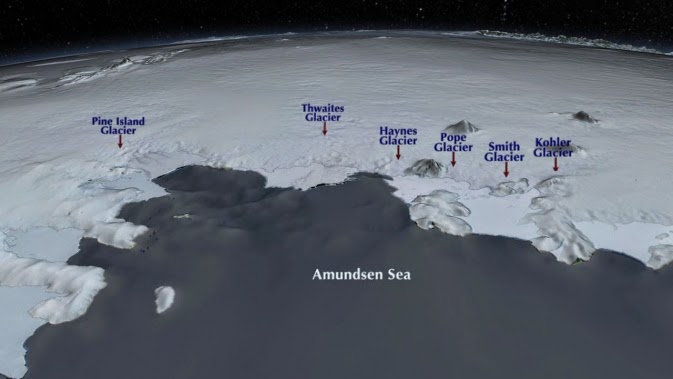Warming temperatures around the planet is expected to cause glaciers to melt more rapidly, adding extra water to the ocean, raising the sea level. The question has been how much the sea level will rise. Will it be a foot or two, or will it be twenty feet. For those of us who live near sea level this is an important question, especially given the amount of critical infrastructure that’s been built at sea level. Airports, bridges, ports, cities, etc.
The glaciers in West Antarctica are particularly concerning because of their size, and recognition by scientists for decades that they’re “unstable.” Today, studies were released saying it’s inevitable those glaciers will collapse into the ocean. The collapse is already underway, and cannot be stopped.
These glaciers end up at the sea shore in a depression that goes below sea level. Scientists recently determined the ocean end of these glaciers are now floating in the water, a condition which makes the collapse inevitable.
The rate of the collapse is “limited by the physics of how fast the ice can flow,” according to Thomas P. Wagner, who runs NASA’s programs on polar ice and helped oversee some of the research.
Scientists have used satellite and air measurements to document![]() an accelerating retreat over the past several decades of six glaciers draining into the Amundsen Sea region.
an accelerating retreat over the past several decades of six glaciers draining into the Amundsen Sea region.
The significance of this threat is that these glaciers, by themselves, could raise sea levels by four feet.
Four feet – just from one small subset of glaciers on Antarctica.
The IPCC reports on climate change project sea level rise between 1-3 feet by 2100.
This tells me that we need to plan for quite a bit of sea level rise. This won’t be a piddly little two feet of sea level rise that can be accommodated by a simple sea wall.
If you live at sea level, is your local government thinking about sea level rise? Are they connecting the dots between greenhouse gas emissions, fossil fuel consumption, and the expense they’re paying to build sea walls? Those of you with a beach house should move it inland, because it will be washed away.
The glaciers in the Admundsen Sea region are only a small portion of the glaciers in West Antarctica. According to NASA’s scientists, if all the West Antarctica glaciers melted completely, global sea level would rise by about 16 feet (5 meters).
The good thing to know is that this process will take awhile – decades – to unfold. The bad news is that because it happens so slowly the danger won’t be recognized until it’s too late. That’s the problem with the whole climate change story – the process of change is fairly slow, taking decades to unfold, and it’s not the sort of threat our bodies evolved to recognize. It’s easy to recognize threats like a lion or bear charging us from the forest. Even if we recognize a threats that takes decades to unfold, that just evokes the “manana” reflex (I’ll take care of it tomorrow).
- Highway design could decrease death and injury risk, if “we” chose smarter designs - March 28, 2015
- GM really did trademark “range anxiety”, only later to abandon that mark - March 25, 2015
- US Government releases new regulations on hydraulic fracturing, that some call “toothless” - March 20, 2015
- Tesla Motors magic pill to solve range anxiety doesn’t quite instill range confidence - March 19, 2015
- Update on Galena IL oil train – 21 cars involved, which were the supposedly safer CP1232 design - March 7, 2015
- Another oil bomb train – why are they shipping crude oil by train? – Symptoms of fossil fuel addiction - March 6, 2015
- Chevron relinquishes fracking in Romania, as part of broader pull-out from Eastern European fracking operations - February 22, 2015
- Answer anti- electric car articles with truth and pride – truth outshines all distortions - February 19, 2015
- Apple taking big risk on developing a car? Please, Apple, don’t go there! - February 16, 2015
- Toyota, Nissan, Honda working on Japanese fuel cell infrastructure for Japanese government - February 12, 2015
















